Archives of Loren Williams Fly Tying Tutorials.
Blue-Winged Olive Comparadun
Fly and Photos by Loren Williams
Al Caucci and Bob Nastasi introduced the Comparadun style of dry fly in the early 1970 and wrote about it in their manual Hatches (and Hatches II ). Prior, Francis Betters tied very similar patterns called the Usual and the Haystack. All 3 feature hair wings splayed on the top of the hook which act to balance and float these low riding thorax patterns. The Comparadun features the addition of outrigger tails which further spread the weight of the rear of the hook across the surface of the water for stabilty and floatation. While Betters' patterns were developed for New York's Ausable River, where stocked and holdover trout are very opportunistic feeders in the fast flowing tannic freestoner; the comparadun was created for the more temperamental wild trout residing on the more placid tailwaters of the Delaware river system. All three patterns have glaring commonalities of floatation, durability and ease of tying.
Following is the method for tying comparaduns as taught to me by Joe Ackourey or Luzerne, PA--my tying mentor to a large degree.
MATERIALS
Hook: Partridge SLD #14-#22
Thread: Lt. Olive
Wing: Dyed dun deer hair
Tail: Dun Microfibetts
Abdomen: Lt. Olive Fly Rite or Superfine Dubbing
Click photos to enlarge!

Mount hook in vise.
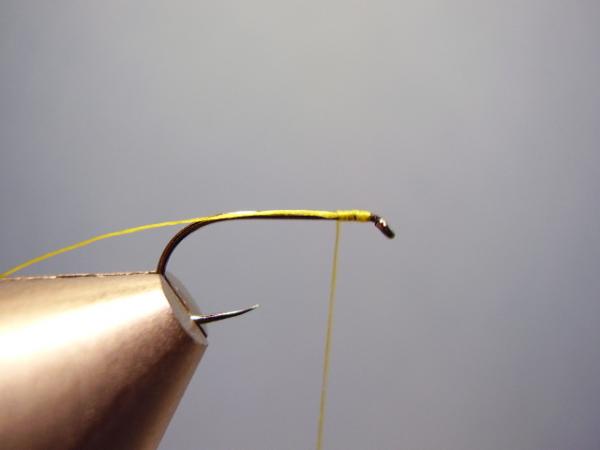
Attach thread behind eye and create a long tag end. DO NOT trim the tag end, instead, bind it to the rear on top of the hook. Do so by lifting up slightly on the tag while securing it with the thread.

Tag secured and placed in the material clip. Thread has been advanced forward to the 2/3 mark denoting the wing location.
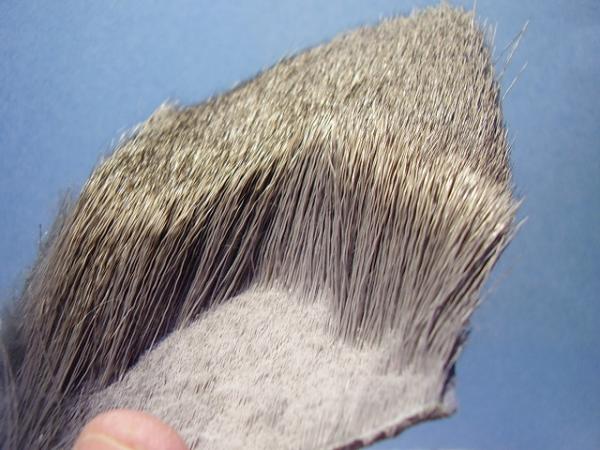
Select a patch of dyed dun coastal deer hair, elk hair or other appropriately sized cervid hair. What is important is that the hair capillaries extend close enough to the tips to allow the hair to flare. Therefore, not all hair will tie comparaduns across all hook sizes.

Select a healthy dollop of hair and snip it off at the base. The proper amount of hair is difficult to describe. Too much results in excessive bulk and to little does a poor job representing wings.

Comb through the butt ends to remove the underfur and shorts.

This stuff is what will be removed.

Place the hair in a midge stacker with the tips down.

Tap a few times and remove the barrel to expose the neatly stacked hair. Be sure that you remove the barrel so that the tips are facing the eye of the hook (facing right for a right-handed tyer).
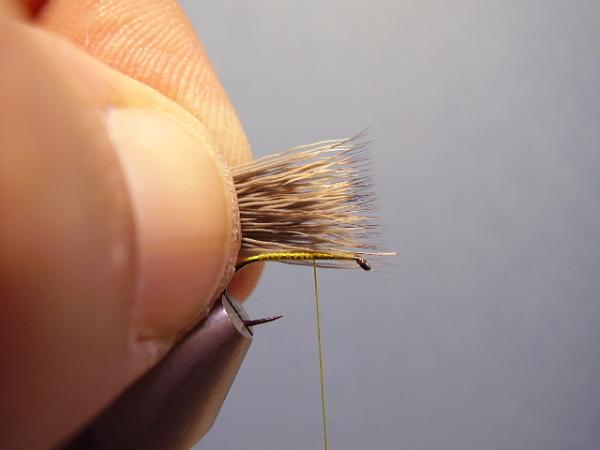
Remove the hair from the stacker by the tips using your bobbin hand, and transfer them, by the butts, to your non bobbin hand. Measure for length against the hook. The wing will be equal to the length of the hook.

Advance the hair forward to the tie-in location marked by your thread. Force the hair down on top of the hook so it roughly encircles the shank.

Take one loose wrap around the hair bundle and hook shank. Do not apply torque and do not let go of the butt ends.
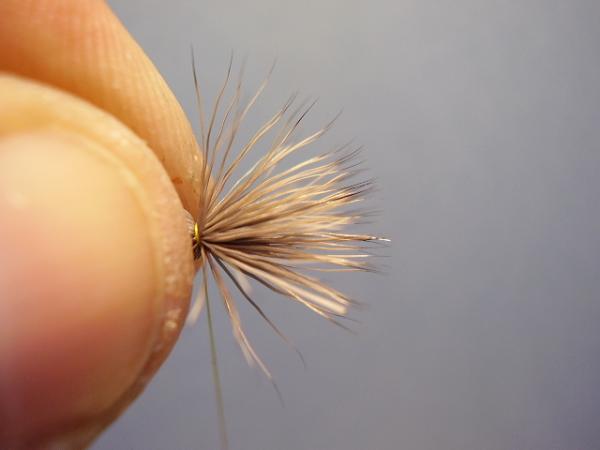
Take a second wrap and start to create some torque to flare the hair. Do not let go of the butt ends.

Take a third wrap and fully tighten down. As you tighten, let go of the butt ends and allow the hair to fully flare around the entire shank.

Take a few more wraps to secure. Lift the butt ends and snip them away--being careful not to clip the thread tag. No need yet to trim the hair flush.

Wrap the thread rearward through the clipped hair. This will cause the individual hairs to stand up.

Now clip the remnants close.

Advance the thread to the rear edge of the hair bundle. You have now just secured the healthy dollop of hair without creating an unsightly lump on top of the shank and behind the wing! Woohoo!

With the thread still behind the bundle, grasp all the hair and pull it all up and to the rear--with force!

Use the thread to create a thread dam in front of the wing. This will gather the hair on top, stand it up and make it flare in the desired 180-degree semicircle.

This is what you are looking for at this point. Don't get too concerned if a few hairs misbehave.
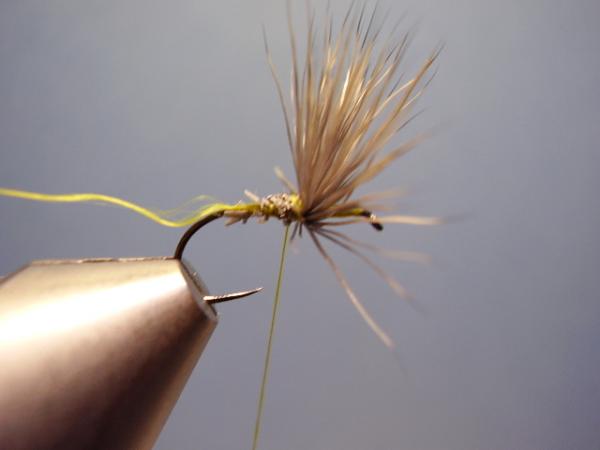
Move the thread to the rear of the wing.

Select your fan of microfibetts.

Separate and remove 4 fibers. I use 6 fibers or #8-#10 hooks; 4 fibers for #12-#14 hooks, and 2 fibers for #16 and smaller. Measure the fibers to be 1 1/2 times the length of the hook.

Secure the fibers on top of the shank behind the wing.

Bind them down the top of the shank to the rear, ending at the bend of the hook.

Advance the thread forward up the abdomen a ways.

Pull the tag of thread forward between the microfibetts effectively splitting them. The tighter you pull the wider they will splay. When satisfied, secure the tag with the thread and clip the excess.

Select a small pinch of dubbing.

Apply it to your thread.

Dub a neat, thinly tapered abdomen. Do not apply dubbing to too much thread at one time. Doing so will create a situation where you lose thread tension as you come over the top of the hook since the hook-to-bobbin distance will be so great. It's better to dub shorter sections of thread and reapply the dubbing as needed.

Come in very tightly behind the wing.

Pull the hair to the rear HARD.

Come forward with the dubbing and be sure to force a number of wraps in tight in front of the wing. Doing so will stabilize the wing offer support.

Dub a neatly tapered thorax.
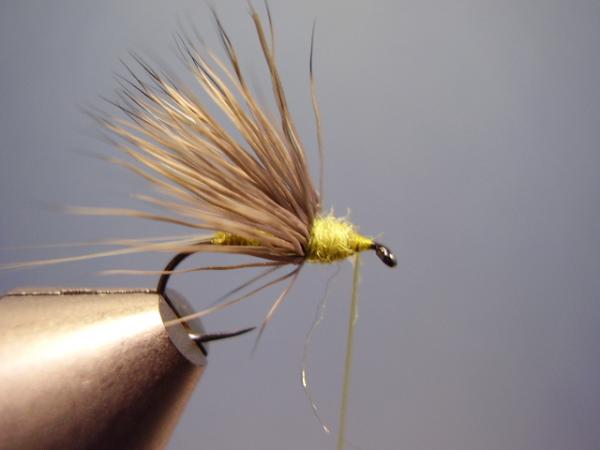
Build a small head.

Whip and clip.

Using your scissors, dress the hair hair back up and clip any hairs that are not playing with the team.
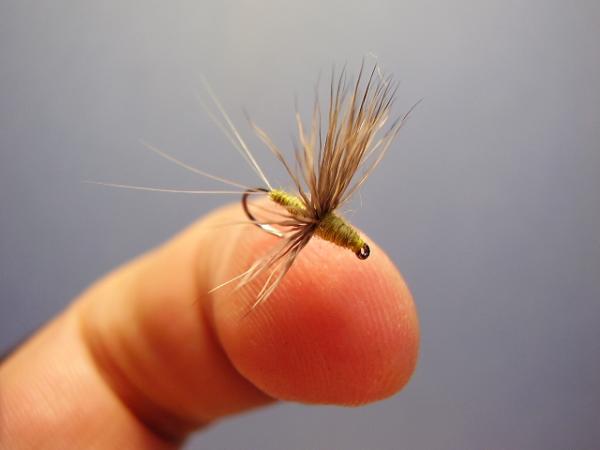
Finished BWO Comparadun.